Application and Residue Pollution of Mulching Films in Xinjiang
, , , , *
1. Agricultural Resources and Environmental Protection Station in Xinjiang, Urumqi 832001, China; 2. Rural Energy and Environmental Protection Work Station of Yili Prefecture, Ghulja 835000, China
ApplicationandResiduePollutionofMulchingFilmsinXinjiang
MingdongZHOU1,HongHOU1,HeganDONG2,HaiyingSU1,XiaohuiQIN1*
1. Agricultural Resources and Environmental Protection Station in Xinjiang, Urumqi 832001, China; 2. Rural Energy and Environmental Protection Work Station of Yili Prefecture, Ghulja 835000, China
In order to study current situation of application, recycling and residue pollution of mulching films in Xinjiang, and accurately grasp pollution degree of residue of mulching films, this paper made an empirical analysis on residue of mulching films in 31 typical counties and cities in Xinjiang. Results indicate that (i) use of mulching films in Xinjiang is wide and there is great difference in use and residue recycling between cities and counties. Planting area and planting structure jointly influence use of mulching films, and the use of mulching films is significantly correlated with recycling of mulching films, but not correlated with recycling rate of mulching films. (ii) There are significant differences in distribution of residue of mulching films, highest in North Xinjiang and South Xinjiang, followed by East Xinjiang, and the lowest in West Xinjiang. (iii) There are significant differences in distribution of residue of mulching films between different crop fields. Residue of mulching films in cotton field is the key problem of pollution.
Xinjiang, Mulching films, Use of mulching films, Residue, Current situation
1 Introduction
Xinjiang Uygur Autonomous Region is situated in Asian-European inland with typical arid and semi-arid climate, dry with little rain but high evaporation. The annual mean precipitation is less than 200 mm, and most areas are below 100 mm which is ineffective. In order to solve huge harm of aridity and formidable natural conditions to agricultural production, Xinjiang Uygur Autonomous Region started popularizing the cotton planting with mulching films as early as the 1980s. Practice indicates that mulching films can protect moisture, save water, reduce weed growth, and promote early maturity of crops[1-2]. Energetically developing mulching film planting technology not only can solve the problem of drought in spring, but also can increase the accumulated temperature, and it plays a great role in developing agricultural production and promoting increase of farmers’ income. However, with gradual increase of use of mulching films, recycling of waste and old mulching films lag behind, white pollution[3-5]constantly deteriorates, and residue of mulching films has become a major factor restricting sustainable agricultural development and income farmers in Xinjiang[6].
Due to vast area and diversified climate in Xinjiang, the difference is great in crop planting and use of mulching films, leading to diversified residue of mulching films in Xinjiang. On the basis of surveying use and recycling of mulching films in 9 prefectures and 31 typical counties and cities of Xinjiang, we comprehensively analyzed current situation of use and residue of mulching films in Xinjiang, in the hope of providing reference for correctly grasping distribution of residue of mulching films and coming up with pertinent measures.
2 Materials and methods
2.1Surveyareas
2.1.1Survey of use and recycling of mulching films. 31 typical counties and cities: Shawan County, Korla City, Jinghe County, Kuqa County, Shache County, Yuli County, Awat County, Shule County, Manas County, Wusu City, Shaya, Aksu City, Emin County, Xinhe County, Wenquan County, Fuhai County, Bole City, Yopurga County, Burqin County, Fuyun County, Yumin County, Habahe County, Ghulja County, Yanqi County, Gongliu, Shanshan County, Yiwu County, Turpan City, Markit County, Hejing County, and Jimsar County.
2.1.2Distribution of residue of mulching films. 9 prefectures are Changji Hui Autonomous Prefecture, Kashgar Prefecture, Bortala Mongol Autonomous Prefecture, Tacheng Prefecture, Aksu Prefecture, Bayingolin Mongol Autonomous Prefecture, Turpan Prefecture, Aletaide Prefecture, Yili Kazakh Autonomous Prefecture.
12 kinds of crops using mulching films are: hot pepper (capsicum annuum), cotton, corn, pigment pepper, leafy and root vegetables, wheat, flowers, processed tomato, melon and fruit, sunflower, potato, and corn for seed.
2.2SurveymethodIn 2014, the bureau of agriculture of counties and cities made statistics of input and recycling of mulching films in 31 typical counties and cities.
In the same year, bureau of agriculture of prefectures surveyed residue of mulching films for 12 kinds of crops in 9 prefectures by 0-20 cm and 20-30 cm soil layers. When selecting sample farmland, the period of use of mulching films was 0-5 a, 6-10 a, 11-15a, 16-20 a (not applicable for some crops), 21-25 a (not applicable for some crops), and 26-30 (not applicable for some crops). Then, we calculated average value as residue of mulching films.
Measurement of residue of mulching films in soil: after dividing sampling plot, we explored soil and picked residue of mulching films. Firstly we removed foreign matters on residue of mulching films, took residue to laboratory and clean. After cleaning, we used absorbent paper to absorb moisture on residual mulching films, extended the residual mulching films to prevent damage, and put them in dry place for natural drying. Finally, we measured the weight of residual mulching films using 1/10000 electronic scale.
2.3DataanalysisWe made variance analysis and multiple comparison of LSD using SPSS20.0, and made drawings using origin8.5.
3 Results and analyses
3.1Currentsituationofuseofmulchingfilmsin31typicalcountiesandcitiesinXinjiangCurrent situation of use of mulching films in 31 typical counties and cities in Xinjiang (use of mulching films, area of mulching films, and percentage of various crops), crops, coverage form and coverage percentage are different.
From Fig. 1, we can see that there is significant difference in use of mulching films among 31 typical counties and cities in Xinjiang. Shawan County has the largest use of mulching films, reaching 8740 tons, which was 90 times of Jimsar County. The top ten counties and cities using mulching films consumed 46858 tons of mulching films in total, accounting for 69.3% of 31 key monitoring counties. Thus, the close attention of controlling mulching film pollution should be paid to these top ten counties and cities. Average weight of mulching films used in 31 counties and cities is 3692 tons, 8 counties exceed the average value, and 23 counties are below the average value. The difference of planting area is the key factor leading to difference in use of mulching films in counties and cities, such as Shawan County and Korla City. Besides, planting structure exerts significant influence on use of mulching films. For example, in Yining County and Gongliu County, agricultural planting area is large, but the use of mulching films is relatively little, mainly because crops such as corn, wheat and beet do not use mulching films, and most crops do not adopt mulching films. In Shawan County, Korla City, and Jinghe County where mulching films are used for a great deal, the 100% cotton adopts mulching films.
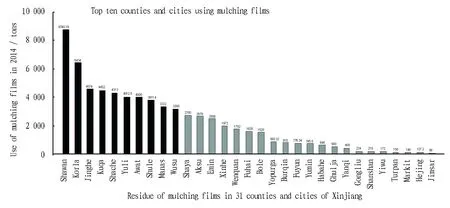
Fig.1 Use of mulching films in 31 counties and cities of Xinjiang
3.2RecyclingofmulchingfilmsFrom Fig. 2, we know that there are significant differences in recycling of mulching films among 31 counties and cities, Korla City is the highest and Turpan City is the lowest. The recycling of mulching films in 31 counties and cities was 39542 tons, accounting for more than half of total use of mulching films. Top ten counties and cities of recycling of mulching films include 9 counties and cities in top ten of use of mulching films, indicating there is significant correlation between recycling and use of mulching films.
From Fig. 3, we know that there is significant difference in recycling rate of mulching films among 31 counties and cities, with Yiwu County the highest and Emin City the lowest. The average recycling rate of mulching films in 31 counties and cities is 58.47%, and the recycling rate of 18 counties and cities exceeds the average recycling rate. In top ten counties and cities of using mulching films, Kuqa County, Manas County, Korla City, Jinghe County, Yuli County, and Shule County have recycling rate of mulching films higher than the average recycling rate. Awat County, Shawan County, and Shache County have low recycling rate of mulching films, especially Shawan County, the recycling rate is extremely low (only 34.38%), which will inevitably lead to large residue of mulching films.
In sum, through survey of 31 counties and cities using mulching, we found that the mulching films are still in large volume in the whole Xinjiang, and there are great differences in use and recycling of mulching films among all counties and cities. Planting area and planting structure jointly influence use of mulching films, and the use of mulching films is significantly correlated with recovery of mulching films, but not correlated with recovery rate of mulching films.
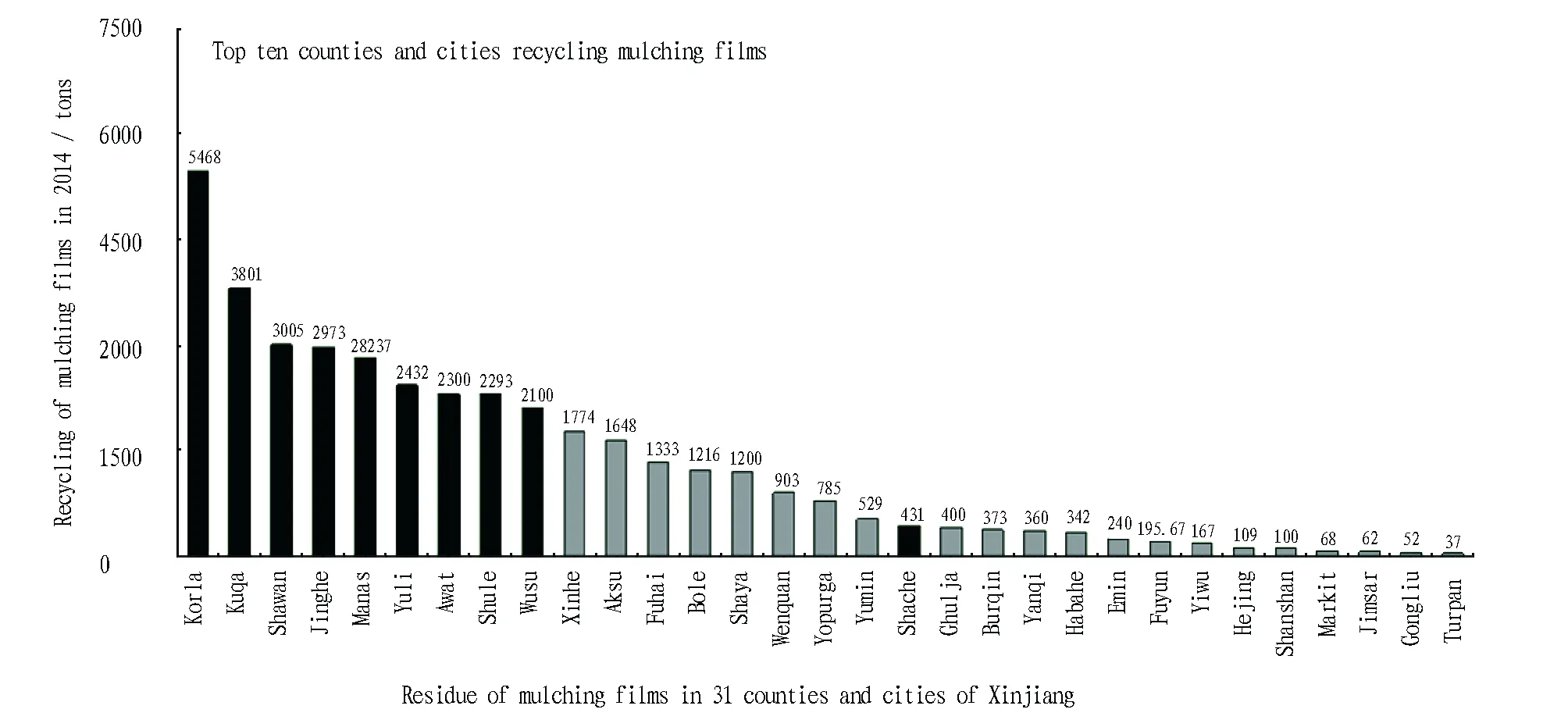
Fig.2 Recycling of mulching films in 31 counties and cities of Xinjiang
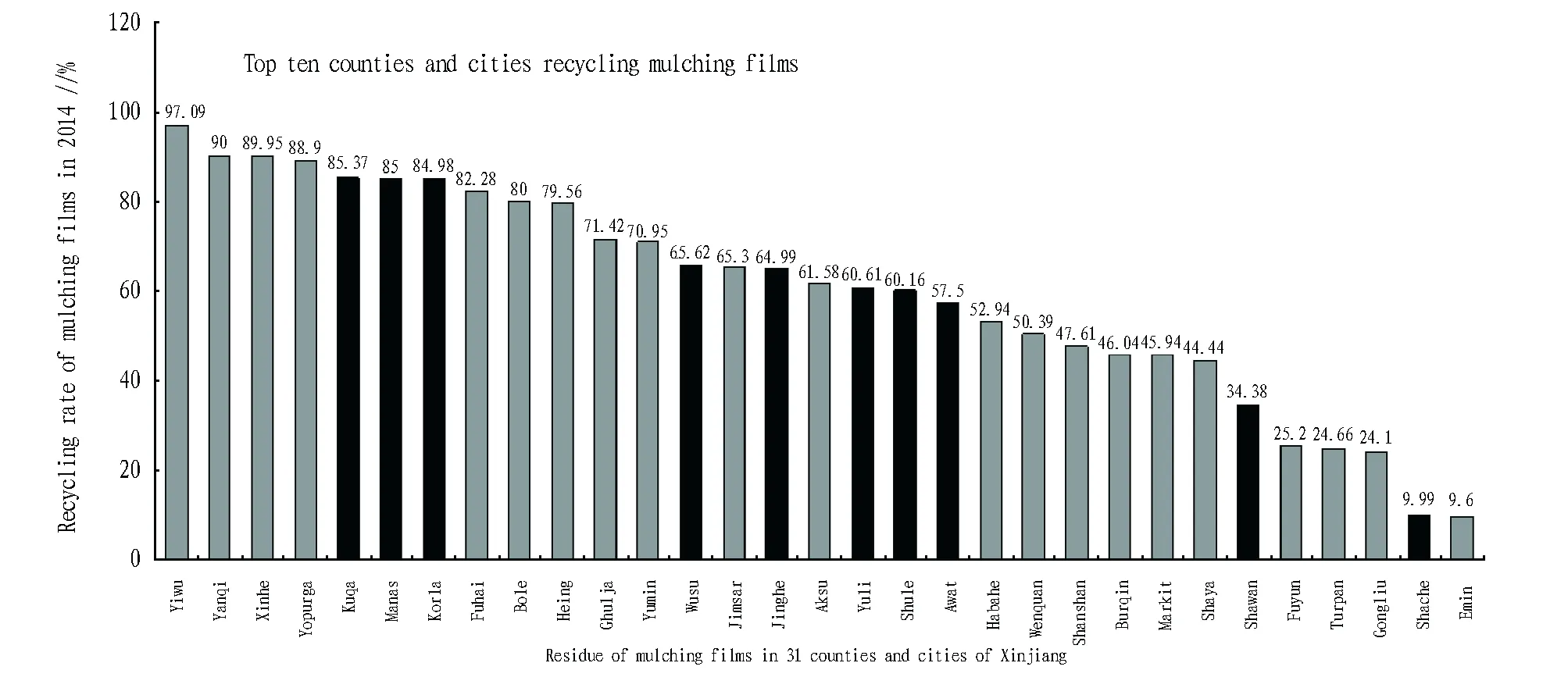
Fig.3 Recycling rate of mulching films in 31 counties and cities of Xinjiang
3.3CurrentsituationofresidueoffarmlandmulchingfilmsFrom Fig. 4-A, it can be known that there are great differences in density of residue of farmland mulching films in 9 prefectures of Xinjiang using mulching films. Changji Hui Autonomous Prefecture, Kashgar Prefecture, and Bortala Mongol Autonomous Prefecture have the largest density of residue of farmland mulching films, followed by Tacheng Prefecture, Aksu Prefecture, Bayingolin Mongol Autonomous Prefecture, and Turpan Prefecture, and the lowest is in Aletaide Prefecture and Yili Kazakh Autonomous Prefecture. Changji Hui Autonomous Prefecture has the density of residue of farmland mulching films up to 263.3 kg/km2, while Yili Prefecture has the density of residue of farmland mulching films only 20.1 kg/hm2, only 1/13 of the density in Changji Prefecture.
The major reason for great difference of residue of farmland mulching films lies in difference of planting structure. Changji Hui Autonomous Prefecture mainly plants cotton and processed tomato which have high coverage of mulching films, while Yili Prefecture mainly plants corn and wheat which require little of mulching films.
From Fig. 4-B, we know that from Aletaide Prefecture to Aksu Prefecture, 0-20 cm soil layer residue of farmland mulching films takes up a greater and greater proportion in total residue of farmland mulching films, indicating that accumulated residue of farmland mulching films is relatively distributed in 0-30 cm soil layer.
There are significant differences in distribution of residue of mulching films, highest in North Xinjiang and South Xinjiang, followed by East Xinjiang, and the lowest in West Xinjiang.
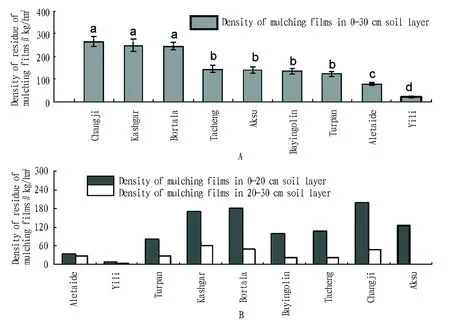
Fig.4 Current situation of residue of mulching films in typical prefectures of Xinjiang

Fig.5 Current situation of residue of mulching films for major crops using mulching films in Xinjiang
From Fig. 5-A, it can be known that there are great differences in density of residue of farmland mulching films in 12 crops of Xinjiang using mulching films. Cotton, corn, and pepper have higher density of residue of mulching films, while potato and corn for seed have lower density of residue of mulching films. The residue of cotton field has reached 197 kg/hm2, while potato field is only 38 kg/hm2, only 1/5.2 of the residue density of cotton field.
The key factor leading to difference in density of residue of mulching films for different crops lies in accumulated coverage times of mulching films and physiological features of crops. For example, cotton has the history of using mulching films as long as 30 years in Xinjiang, while the corn for seed has short history of using mulching films, leading to residue of mulching films in cotton field much more than residue of mulching films in corn for seed. Besides, cotton and corn have developed root system and higher over-ground parts which increase the difficulty of recycling of mulching films, while potato and other vegetables have relatively simple root system and short over-ground parts which are favorable for recycling of mulching films.
From Fig. 5-B, we know that the density of residue of mulching films in 0-20 cm soil layer of sunflower field is smaller than 20-30 cm soil layer, while other crops have higher density of residue of mulching films in 0-20 cm soil layer than 20-30 cm soil layer. The major reason for spatial distribution difference of residue of mulching films is different physiological characteristics of different crops. In sum, there are significant differences in distribution of residue of mulching films between different crop fields. Combining density of residue of mulching films and crop planting area, the residue of mulching films in cotton field is most prominent.
4 Conclusions
(i) The mulching films are still in large volume in the whole Xinjiang, and there are great differences in use and recycling of mulching films among all counties and cities. Planting area and planting structure jointly influence use of mulching films, and the use of mulching films is significantly correlated with recovery of mulching films, but not correlated with recovery rate of mulching films. It is recommended to start from key counties and cities to control the problem of residue of mulching films, especially in Shawan County and Shache County which have large volume of use but low recycling rate of mulching films.
(ii) There are significant differences in distribution of residue of mulching films, highest in North Xinjiang and South Xinjiang, followed by East Xinjiang, and the lowest in West Xinjiang. Changji, Bortala, Bayingolin, Aksu, and Kashgar prefectures have large planting area, mainly cotton and processed tomato, and the use of mulching films has a long history. In addition to shortage of water resources, the use of mulching films is still in large volume and accumulation of residue of mulching films is also very high. In comparison, Yili and Aletaide prefectures have abundant water resources, the use of mulching films is little, and accumulation of residue of mulching films is also very little.
(iii) There are significant differences in distribution of residue of mulching films between different crop fields. Xinjiang is the major area of cotton production in China, the problem of residue of mulching films in cotton field is very prominent. Therefore, it is urgent to solve the problem of residue of mulching films in cotton field.
[1] Anikwe MAN, Mbah CN, Ezeaku PI,etal. Tillage and plastic mulch effects on soil properties and growth and yield of cocoyam (Colocasia esculenta) on an ultisol in southeastern Nigeria[J]. Soil and Tillage Research, 2007, 93(2): 264-272.
[2] Mahajan G, Sharda R, Kumar A,etal. Effect of plastic mulch on economizing irrigation water and weed control in baby corn sown by different methods [J]. African Journal of Agricultural Research, 2007, 2(1): 19-26.
[3] DU XM, XU G, XU DP,etal. Mulch film residue contamination in typical areas of North China and countermeasures [J]. Transactions of the Chinese Society of Agricultural Engineering,2005,21(13):225-227. (in Chinese).
[4] XIE HE, LI YS, YANG SQ,etal. Influence of residual plastic film on soil structure, crop growth and development in fields [J]. Journal of Agro-Environment Science,2007,26(z1):153-156. (in Chinese).
[5] YAN CR, MEI XR, HE WQ,etal. Present situation of residue pollution of mulching plastic film and controlling measures[J]. Transactions of the Chinese Society of Agricultural Engineering,2006,22(11):269-272. (in Chinese).
[6] DONG HG, LIU T, LI YG,etal. Effects of plastic film residue on cotton yield and soil physical and chemical properties in Xinjiang [J]. Transactions of the Chinese Society of Agricultural Engineering,2013,29(8):91-99. (in Chinese).
[7] ZHANG CF, HUANG YL, ZHOU Hetal. Effects of plastic film mulching on physical characters of soil and yield and yield components of sweet potato[J]. Agricultural Science & Technology, 2015, 16(11): 2379-2385, 2393
November 25, 2015 Accepted: January 6, 2016
*Corresponding author. E-mail: 445485955@qq.com
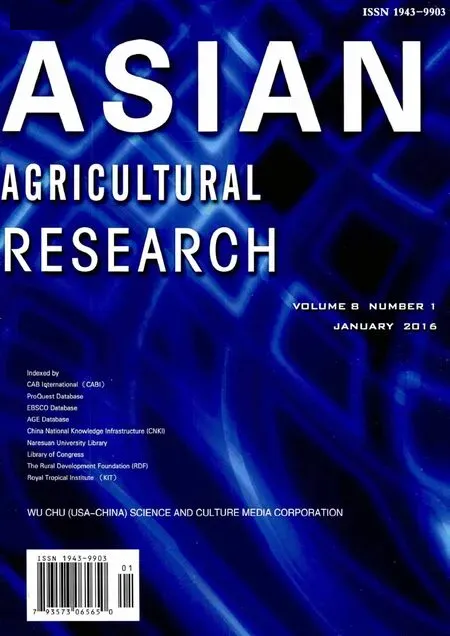 Asian Agricultural Research2016年1期
Asian Agricultural Research2016年1期
- Asian Agricultural Research的其它文章
- Resource Dependence Relationship between Grass-roots Government and Farmers’ Specialized Cooperatives
- Urban Residents’ Consumption Risk Perception about the Dairy Products
- Study on the Aromatic Components of Green Plum Wine by HS-SPME-GC-MS
- Effect of Vacuum Packaging on Storage Quality of Peanut
- Innovative Development of Fishery and Ecological Protection of Poyang Lake
- Effect of Silicon Application on Rice Growth and Production Structure
